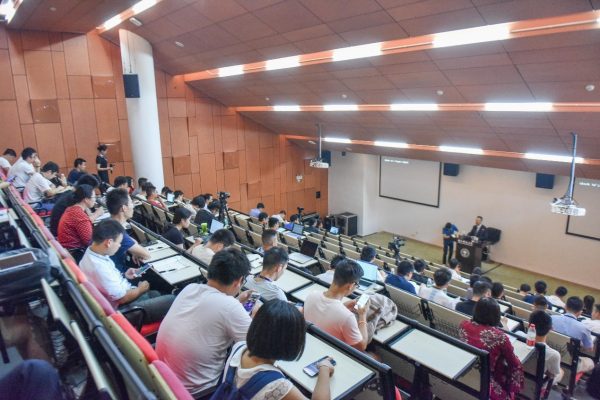Last week, Southern University of Science and Technology (SUSTech) welcomed Director of Laser Processing Research Centre at The University of Manchester UK Professor Li Lin to campus to give the 235th lecture in the SUSTech Lecture Series. His insightful lecture on materials and functional gradient components was hosted by College of Engineering Dean Xu Zhenghe.
Professor Lin Li, a Fellow of the Royal Academy of Engineering, United Kingdom, holds a chair of laser engineering, Director of Laser Processing Research Centre at The University of Manchester UK. He has over 390 publications in peer-reviewed journals and 60 patents related to laser processing and photonic science. He was elected to Fellow of International Academy for Production Engineering (CIRP), Fellow of Institute of Engineering and Technology (IET), and Fellow of Laser Institute of America (LIA).
Professor Li received the Arthur Charles Main Award from the Institute of Mechanical Engineers in 2001, the Sir Frank Whittle Medal from the Royal Academy of Engineering in 2013, the Wolfson Research Merit Award from the Royal Society in 2014 and the Researcher of the Year medal in Engineering and Physical Sciences at the University of Manchester in 2014.

In the lecture, Li Lin talked about the importance and challenges of adding materials manufacturing with various materials, and focused on his team’s research achievements in multi-material adding materials manufacturing. He pointed out that the common powder-laying process of SLM has great limitations in the printing of multi-material gradient components. To solve the problems, Li Lin’s team proposed and designed a new SLM machine. The main idea is to absorb the powder at the designated position through the micro-nozzle and lay other powders at that position during the printing process. In order to facilitate the design of corresponding process parameters for different materials, their team also designed a new path planning software. Since materials are the most critical component in manufacturing multi-material additives, the physical & chemical properties of different materials must be accounted for when mixing many different materials together.
The idea of Li Lin’s team to deal with the interface is to use the method of fuzzy gradient transition to construct the interface layer, reducing the sensitivity between materials transition. There are still some bottlenecks in this process, and more work is needed to overcome these difficulties.
Professor Li Lin took many questions from the audience at the end of the lecture.
Proofread ByXia Yingying
Photo ByStudent News Agency Yang Yuxuan Xiao Xiaoyu